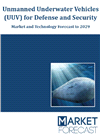DARPA’s Manta Ray Program aims to demonstrate critical technologies for a new class of long duration, long range, payload-capable unmanned underwater vehicles (UUVs). UUVs that operate for extended durations without the need for on-site human logistics support or maintenance offer the potential for persistent operations during longer term deployments.
DARPA has selected three companies to focus on development of an integrated solution for Manta Ray technology and operational areas. They are:
A fourth company, Metron, Inc., will work toward critical technology and solutions specific to the field of undersea energy harvesting techniques at depths necessary for successful operations.

Market forecasts by Region, Spending Element, and End-Use. Current and Future UUV technologies, Country analysis, Market Dynamics, Opportunity and Scenario Analysis, and Leading Companies
Download free sample pages More information“The Manta Ray program aims to increase at-sea operational capacity and capabilities for the combatant commander while minimizing disruptions to current operations by remaining independent of crewed vessels and ports once deployed,” said CDR Kyle Woerner, the Manta Ray program manager in DARPA’s Tactical Technology Office. “If successful, this new class of UUVs would allow operational flexibility and relief of workload for both traditional host ships and servicing ports.”
The Manta Ray program plans to advance key technologies that will benefit future UUV designs, including, but not limited to new energy management and energy harvesting techniques at operationally relevant depths; low-power, high-efficiency propulsion; and new approaches to mitigate biofouling, corrosion, and other material degradation for long duration missions. The program also seeks process improvements, including mission management approaches for extended durations while accounting for dynamic maritime environments; unique methods for leveraging existing maritime datasets and new maritime parameters for high-efficiency navigation; and new low-power means of underwater detection and classification of hazards.
Manta Ray is targeting three phases of development, culminating with a fully integrated demonstration vehicle completing an underwater mission in a dynamic, open-ocean environment.